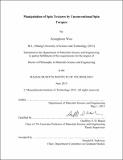Manipulation of spin textures by unconventional spin torques
Author(s)
Woo, Seonghoon
DownloadFull printable version (6.811Mb)
Other Contributors
Massachusetts Institute of Technology. Department of Materials Science and Engineering.
Advisor
Geoffrey S. D. Beach.
Terms of use
Metadata
Show full item recordAbstract
Dynamically controlling magnetism at the nanoscale is the foundation for realizing high-performance, low-power solid-state spintronic devices. The manipulation of nonuniform magnetization textures such as domain walls and skyrmions provide both a means to control magnetism in devices, and to gain new fundamental insights into spin-charge and spin-orbital interactions in magnetic materials. In this thesis, we examine novel mechanisms for the evolution and control of nonuniform magnetization textures. We first show that magnonic spin currents due to spin wave propagation can couple to and drive magnetic domain walls in nanowires mainly with experiments, supported by micromagnetic simulations. This work highlights a route towards integrating domain walls and spin waves for enhanced functionality in spintronics applications. We then focus on pure spin currents generated at the interface between a metallic ferromagnet and a heavy metal due to the spin Hall effect induced by strong spin orbit interaction. We demonstrate that the spin Hall effect can efficiently amplify or attenuate spin waves in an adjacent ferromagnet, and the efficiency of spin current generation can also be dramatically enhanced by optimizing the ferromagnet/heavy-metal interfaces. Moreover, we describe the microscopic mechanisms by which the spin Hall effect leads to magnetization switching, in the presence of chiral exchange interactions due to interfacial Dzyaloshinskii-Moriya interaction. This work shows the essential role that Dzyaloshinskii-Moriya interaction plays in magnetization switching. Finally, by harnessing this effect in carefully engineered materials, we show for the first time that the Dzyaloshinskii-Moriya interaction can stabilize topologically-protected skyrmions, whose statics and dynamics we have imaged for the first time in transition-metal ferromagnets at room temperature without any static external bias field. This finding provides not only experimental evidence of recent predictions but also opens the door to room-temperature skyrmion spintronics in robust thin-film heterostructures
Description
Thesis: Ph. D., Massachusetts Institute of Technology, Department of Materials Science and Engineering, 2015. This electronic version was submitted by the student author. The certified thesis is available in the Institute Archives and Special Collections. Cataloged from student-submitted PDF version of thesis. Includes bibliographical references.
Date issued
2015Department
Massachusetts Institute of Technology. Department of Materials Science and EngineeringPublisher
Massachusetts Institute of Technology
Keywords
Materials Science and Engineering.